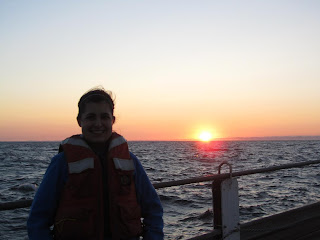[Ed: We'll have a few follow-up posts about the cruise now that we're back on land.]
Lots of Data!
Hello!
Well the cruise is
over, the equipment is packed, and the data binder is tucked safely
in my backpack! We just have a couple more days in Oregon and then
it's back to Long Island! I am happy to report that we titrated 1,524
organisms on this cruise! This means I have a lot of data analysis to
do when I get home! I wanted to explain how we use our titration data
to calculate an organism's density since it was never fully explained
earlier. When titrating, we record the amount of seawater and
glycerin mix that was added to make the organisms become neutrally
buoyant, as well as the temperature and salinity of the seawater. We
use the temperature and salinity to calculate the density of
seawater. The density of the glycerin mix is calculated from the
density of glycerin and the density of seawater. We then use these
values in the following equation to calculate the animal's density.
Animal Density = (
(Seawater Density * Seawater Volume) + (Mix Density * Mix
Volume))/(Seawater Volume + Mix Volume)
We can then use the
animal's density in a model that helps us understand how these
animals scatter sound. This information can allow us to use acoustic
data to make estimates about how many animals are in the water
column.
It was such a great
cruise and I have enjoyed being a tourist and getting to see some of
Oregon before our trek back to Long Island. With over 1500 organisms
measured, I'm predicting a very busy semester filled with data
analysis!!
Until our next cruise.
Kaylyn
The ALES team
on the bow of the Oceanus! Photo credit: Kelly Benoit-Bird
Steph and I
busy at collecting data! We each titrated over 600 organisms!! Photo
credit: Dezhang Chu.
We spotted
some California sea lions in Newport when we went to lunch after we
got off of the boat!!















































